Theater 2013-14: TimeLine will raise curtain with fresh look at classic ‘Raisin in the Sun’
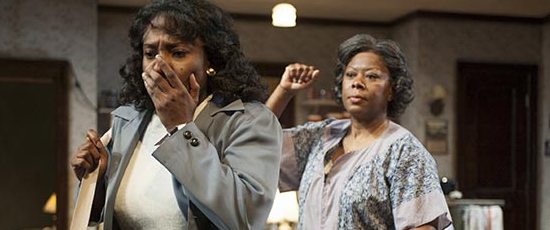 First in a series of season previews: Lorraine Hansberry’s 1959 drama and the Chicago premiere of Marc Blitzstein musical “Juno” bookend a season that opens Aug. 20.
First in a series of season previews: Lorraine Hansberry’s 1959 drama and the Chicago premiere of Marc Blitzstein musical “Juno” bookend a season that opens Aug. 20.
By Lawrence B. Johnson
TimeLine Theatre rolls into its 17th season by turning back the clock more than half a century to Lorraine Hansberry’s classic story of racial prejudice in Chicago, “A Raisin in the Sun.”
The season opener, TimeLine’s first-ever production of “A Raisin in the Sun” will be directed by Ron OJ Parson, who shepherded Milwaukee Repertory Theatre’s staging of the play last season. Though two of the Milwaukee Rep leads will appear at TimeLine – Greta Oglesby as Lena Younger, who’s bent on seeing her family better situated, and Mildred Marie Langford as her daughter Beneatha, who dreams of a medical career – this production will be a complete rethinking of the work, from sets to concept.
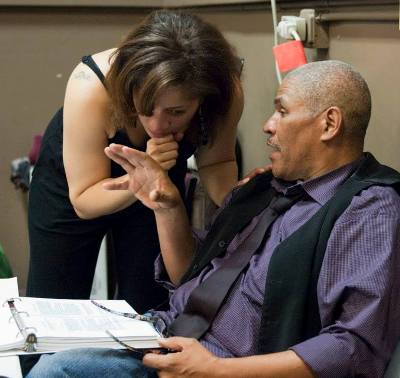 Lorraine Hansberry’s play, about a poor African American family on Chicago’s south side that comes into money and buys a house in an all-white neighborhood, was a daring venture on the American stage. It also would become the inspiration for Bruce Norris’ “Clybourne Park,” an updated sequel that won the Pulitzer Prize for drama in 2011.
Lorraine Hansberry’s play, about a poor African American family on Chicago’s south side that comes into money and buys a house in an all-white neighborhood, was a daring venture on the American stage. It also would become the inspiration for Bruce Norris’ “Clybourne Park,” an updated sequel that won the Pulitzer Prize for drama in 2011.
“This country has made many societal advances since ‘A Raisin in the Sun’ first appeared in the pre-civil rights ‘50s, and it may seem like a relic of a happily bygone era,” says TimeLine artistic director PJ Powers. “But that’s missing a larger point. The racial bias that confronts the Younger family in Lorraine Hansberry’s play is still with us today. Chicago seems to be as fractured and splintered into segregated neighborhoods as much now as ever.
 “We’re living a tale of two cities. Depending on what neighborhood you’re in, and the huge issues of opportunity either greatly impact your life or you’re not aware of them at all.”
“We’re living a tale of two cities. Depending on what neighborhood you’re in, and the huge issues of opportunity either greatly impact your life or you’re not aware of them at all.”
Powers admits that the Milwaukee Rep staging was his first live experience with the play. “I’ve been amazed to discover how few people these days have actually seen ‘A Raisin in the Sun,’” he says. “I can’t tell you how many theater people have told me, quite sheepishly, that they’ve never seen it.”
The 2013-14 season in brief:
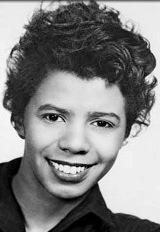 “A Raisin in the Sun” by Lorraine Hansberry (Aug. 20-Nov. 17): When Lena Younger gets a check for $10,000 from her late husband’s life insurance, she sees a chance to move her family out of their decrepit south side Chicago apartment and into a nice home in all-white Clybourne Park. But her grown son and daughter have their own ideas about how to use the windfall, and her prospective white neighbors mount determined resistance. “At its core, ‘A Raisin in the Sun’ is about leveling society’s playing field,” says Powers. “The intimacy of our space is going to make this an intensely immersive experience.”
“A Raisin in the Sun” by Lorraine Hansberry (Aug. 20-Nov. 17): When Lena Younger gets a check for $10,000 from her late husband’s life insurance, she sees a chance to move her family out of their decrepit south side Chicago apartment and into a nice home in all-white Clybourne Park. But her grown son and daughter have their own ideas about how to use the windfall, and her prospective white neighbors mount determined resistance. “At its core, ‘A Raisin in the Sun’ is about leveling society’s playing field,” says Powers. “The intimacy of our space is going to make this an intensely immersive experience.”- “The Normal Heart” by Larry Kramer (Oct. 26-Dec. 22): Set during the height of the 1980s AIDS crisis, Kramer’s play follows on determined man’s effort to raise social consciousness about the devastating toll of AIDS – and to generate funding for research to combat the disease. “The cry of this play may not be as urgent as it was in the ‘80s,” says Powers, “but its potency is still as strong. The beauty of Larry Kramer is that he pulled no punches. He’s equally brutal and scathing toward both the heterosexual and homosexual communities. And we are thrilled that David Cromer will be returning to the Chicago stage in this production.”
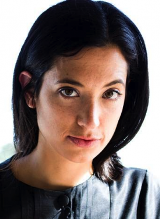 “The How and the Why” by Sarah Treem (Jan. 28-April 6, 2014): A principal writer for the television series “In Treatment,” Treem turns her psychological insight here to a meeting of two female evolutionary biologists who collide over both their perspectives on evolution and their ideas about feminism. “It’s a generational clash between a woman whose career rose in the wake of the feminist movement and another who is trying to have it all – career, family, love,” says Powers. “It’s an incredibly smart play. To sit in the company of Janet Ulrich Brooks and Elizabeth Ledo for 90 minutes as they have this great debate is going to be a real treat.”
“The How and the Why” by Sarah Treem (Jan. 28-April 6, 2014): A principal writer for the television series “In Treatment,” Treem turns her psychological insight here to a meeting of two female evolutionary biologists who collide over both their perspectives on evolution and their ideas about feminism. “It’s a generational clash between a woman whose career rose in the wake of the feminist movement and another who is trying to have it all – career, family, love,” says Powers. “It’s an incredibly smart play. To sit in the company of Janet Ulrich Brooks and Elizabeth Ledo for 90 minutes as they have this great debate is going to be a real treat.”- “Juno,” music and lyrics by Marc Blitzstein, book by Joseph Stein (Chicago Premiere, April 23-July 27, 2014): It seems this 1959 musical adaptation of Sean O’Casey’s 1924 drama “Juno and the Paycock” is only now making its Chicago debut. Set in 1922 during the Irish civil war, the play deals with indigent Irish family that suddenly finds itself the beneficiary of a large inheritance – only to see the puff of hope begin to dissipate. “Stein and Blitzstein have preserved the greatness of O’Casey’s play while allowing its special moments of humanity and humor to soar through music. It’s a crime this musical has been put in the ‘unknown’ trunk. We’ve been wanting to do it for years.”
Getting there:
Most of TimeLine Theatre Company’s productions are performed inside a church building at 615 W. Wellington Ave., a pleasant residential street in the Lakeview East neighborhood, north of the Loop within easy walking distance of the Belmont CTA train stop (Red, Brown and Purple lines). There are a number of other theaters in this area, including Briar Street (where “Blue Man Group” is playing), Laugh Factory, Red Tape, Theater Wit, Comedy Sportz and Stage 773. But the company’s following has grown so large that it actually produces more than 52 weeks of theater annually. Consequently, the first production of this season, “33 Variations,” will be renting performance space at nearby Stage 773, 1225 W. Belmont Ave., Chicago.
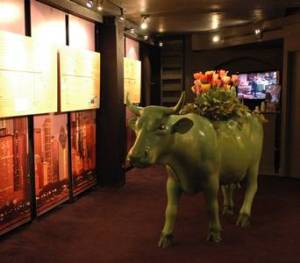 Rewards of arriving early:
Rewards of arriving early:
TimeLine’s lobby exhibitions are like a feast before the meal, a curated gallery filled with historical photographs, graphical charts, and even whimsical objects to put the audience in the mood of the play at hand. Company member Maren Robinson, who has functioned as the dramaturg of numerous shows since 2004, says, “We tend to have a whole separate conversation about what we’re going to do in the lobby, and it’s not always intuitively obvious.
“For example, when we did ‘The History Boys,’ which is set in an English public grammar school, we didn’t do big displays about England and Oxford and Cambridge. Instead, we created the boys’ individual rooms. One had a poster of a girl in a swing, others had sheet music and books that were referred to in the play, such as poets from WWII and a French-English pocket dictionary of the sort they would have used. These were not wealthy boys. Most of them would have lived at home. People were fascinated by the rooms, and they didn’t even realize they were digesting the dramaturgy.”
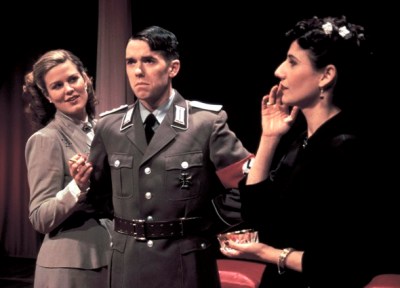 TimeLine’s roots:
TimeLine’s roots:
Chicago theater companies have often been formed by a group of actors who pooled their resources. TimeLine’s original members kicked in $50 each toward getting the company off the ground in 1997. They mounted their first play in 1998 — “Summit Conference,” about a meeting between the mistresses of Hitler and Mussolini. In a blog of reminiscences, the members recall the play had three characters, and at one performance there were only two people in the audience.
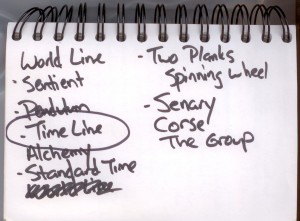 Many of the original members are still with TimeLine, and their rambling blog of memories is hilarious, especially as it pertains to how they decided on their name — it could have been Sentient Theatre Company! — and how they negotiated early adventures such as tracking down a Nazi uniform for “Summit Conference” from a guy in a van in a parking lot.
Many of the original members are still with TimeLine, and their rambling blog of memories is hilarious, especially as it pertains to how they decided on their name — it could have been Sentient Theatre Company! — and how they negotiated early adventures such as tracking down a Nazi uniform for “Summit Conference” from a guy in a van in a parking lot.
The team to this day remains fiercely democratic in its decision making. Powers, who became the artistic director in 1999, finds it “amazing that while we have evolved and matured, at our core we have stayed the same.”
Related Links:
- TimeLine Theatre Company official website: Go to timelinetheatre.com
- Backstage musings by TimeLine Company members: Go to Behind the ‘Line
- TimeLine production history: Go to year-by-year breakdown at timelinetheatre.com
- Chicago premiere of J.T. Rogers’ “Blood and Gifts”: Read the review at ChicagoOntheAisle.com
- World premiere of Susan Felder’s “Wasteland”: Read the review at ChicagoOntheAisle.com
- Chicago premiere of Moisés Kaufman’s “33 Variations”: Read the review at ChicagoOntheAisle.com
- World premiere of John Conroy’s “My Kind of Town”: Read the review at ChicagoOntheAisle.com
- Chicago premiere of Lee Hall’s “The Pitmen Painters”: Read the review at ChicagoOntheAisle.com
- Chicago premiere of Lee Blessing’s “A Walk in the Woods”: Read the review at ChicagoOntheAisle.com
- Role Playing: Kareem Bandealy as an Afghan war lord in “Blood and Gifts”
- Role Playing: Dan Waller as a North England coal miner in “The Pitmen Painters”
- Role Playing: Janet Ulrich Brooks as a Russian arms negotiator in “A Walk in the Woods”
Photo credits and captions: Home page and top: Revisiting their roles from a recent Milwaukee Rep production of “A Raisin in the Sun,” seen here, are Mildred Marie Langford, left, as Beneatha Younger and Greta Oglesby as her mother Lena. (Photo by Michael Brosilow) Descending: Toni Martin, who will play Ruth Younger, with director Ron OJ Parson. (Photo by Lara Goetsch) The TimeLine logo. Playwright Lorraine Hansberry. Playwright Sarah Treem. The TimeLine lobby is always festooned with documentation pertaining to the play and its period. (Photo by Lara Goetsch) TimeLine’s first production, “Summit Conference,” starred Juliet Hart as Eva Braun, Pat Tiedemann as Clara Petacci and PJ Powers as a soldier. (Photo by John Bridges)
Tags: A Raisin in the Sun, Joseph Stein, Juno, Larry Kramer, Lorraine Hansberry, Marc Blitzstein, Milwaukee Repertory Theatre, PJ Powers, Ron OJ Parson, Sarah Treem, Sean O"Casey, The How and the Why, The Normal Heart, TimeLine Theatre

